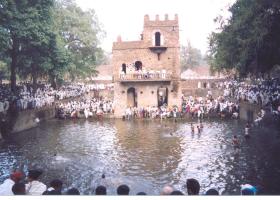Gondar
declined during the chaotic Era of the Princes (1706-1853 A.D.), when powerful
local warlords dominated the emperors who lived among the crumbling palaces. The
emperor Tewodros II, whose supremacy ended the anarchy of the Princes, sacked
Gondar twice during the 1860s, removing the treasures of its churches. The troops
of the Mahdi, the Islamic reformer who founded a state in neighboring Sudan, also
burned the city during the 1880s. Many of the most impressive castles and churches
remain, however, along with a charming pavilion known as the Bath of Fasiladas
where the festival of Timkat is still celebrated every year to mark the baptism
of Christ.
The city was an emporium along important caravan routes between
the north and the south, and most of the trade was in the hands of Muslim merchants
who lived in a separate quarter of the city. Gondar was also home to Beta Israel,
"the House of Israel," who claimed to be Jews. They are also known as
Felasha, a word that seems to refer to their separation from the rest of Ethiopian
society, and Falasha craftsmen provided many essential skills that Ethiopian Christians
were unwilling to perform, from pottery to metalwork.
Today Gondar is an
important regional economic and cultural center and the capital of Gondar province.

GONDAR(2200m Altitude)
The world’s heritage site.
Gondar, with
its spectacular castles, was the capital of the Ethiopia kingdom from the 17th
through the 19th century. In 1632 the Emperor Fasiladas built the first castle
at Gondar, then a village near Lake Tana. He may not have intended to create a
new capital, but he hoped to find a better residence during the rainy season than
the tents of the earlier nomadic court. During the following decades, however,
Gondar did become the capital of the empire, and it remained so until the middle
of the 19th century. It seems that each emperor built his own castle, ignoring
those of his ancestors - a custom that may lie in the competitive nature of Amhara
and Tigrinya society, where young men have traditionally proved their status by
surpassing their elders as well as their rivals.
The castle of Fasiledes
is the most magnificent of all. His son, Yohannes, who succeeded him, added a
chancellery and library. Iyasu’s palace is said to have been the most orate
of all. His assassination by his own son was followed by a period of murders and
poisonings and court intrigues, gory reading, which lasted until the reign of
Bakaffa and his clever wife Mentwab, who outlived her husband and several succeeding
kings. Iyasu II was the last of Gondarine kings. His own palace still stands to
the west of the city. Those of Mentwab, and Bakaffa are within the compound walls.
A massive crenellated wall with twelve gates surrounds the Castles. The compound
is situated in the center of the town.
The fact that their defensive walls
would not have withstood the military technology of the day suggests that they
were constructed largely for display. Ethiopian emperors liked to display their
wealth and power by employing foreign experts, and some scholars believe the palaces
incorporate the skills of Italian or Indian masons, as contacts with both countries
had increased after the Portuguese had arrived in Ethiopia in the 16th century.
Other treasures of Gondar include:
- The Bath of Fasiladas: - Built near a river, about 2kms far from the center, is empty most of the time. The pool is filled with water on Timket Festival (Ethiopian Epiphany) brought through the canals. Timket-feast of Epiphany, one of the greatest festivals of Orthodox Christians, is celebrated colorfully with huge and dramatic processions at this place.
- The church of Debre Berhan Selassie:-The beautiful and famous church of Debre Berhan Selasie was built by Iyasu the great in 17th century. He richly endowed the church with gold treasures and works of art. The inner walls of this rectangular shaped church were marvelously painted from top to bottom with innumerable scenes of Biblical lore and medieval history.
- The ruined Palace of Kusquam, and
- The 18th century Palace of Ras Beit,

